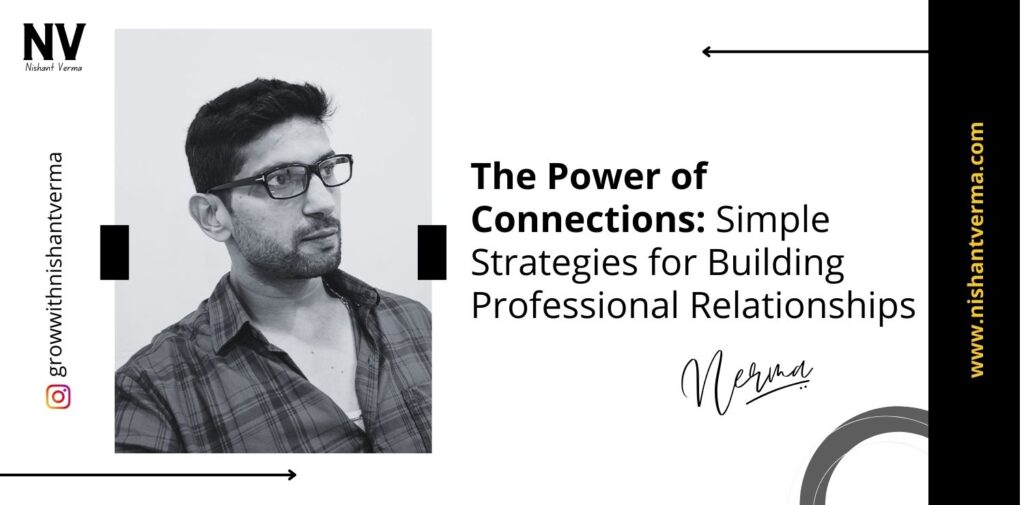In the world of work, it’s not just what you know; it’s also who you know. Building professional relationships, or networking, is a key ingredient for success. In this article, we’ll explore the importance of leadership in networking and share some easy and simple strategies to help you build meaningful connections in your cjourney.

1. Understanding the Basics of Networking
Networking is like making friends at work. It involves connecting with people in your field, sharing ideas, and learning from one another. Whether you’re a leader or a team member, networking opens doors to opportunities, knowledge, and support.
Leadership in networking means building your connections and helping your team members do the same. Leaders fostering a networking culture create a collaborative environment where everyone can grow and succeed.
2. Being Approachable and Friendly: Building professional relationships
One of the simplest ways to start networking is by being approachable and friendly. Smile, make eye contact, and be open to conversations. A friendly demeanor makes it easier for others to connect with you, whether you’re attending a conference, a meeting, or a casual work event.
Leaders can set the tone by being approachable themselves. Encourage team members to engage with others and create a workplace where everyone feels comfortable reaching out to one another.
3. Perfecting the Elevator Pitch
Imagine you’re in an elevator with someone influential in your industry and have a short ride to impress them. That’s where the elevator pitch comes in. It briefly introduces who you are, what you do, and what makes you stand out.
Leaders can guide their teams in crafting effective elevator pitches. Encourage team members to be clear, concise, and compelling when introducing themselves. A well-crafted elevator pitch is a powerful tool for making a memorable first impression.

4. Actively Listening
Networking is not just about talking; it’s also about listening. When you actively listen to others, you show genuine interest in what they say. Ask questions, show curiosity, and make others feel heard.
Leaders can model active listening by engaging in meaningful conversations with their team. By demonstrating the importance of listening, leaders encourage a workplace culture of respect and understanding.
5. Utilizing Social Media
In today’s digital age, social media is a valuable tool for networking. Platforms like LinkedIn provide opportunities to connect with professionals globally. Create a Building professional relationships and up-to-date profile, join relevant groups, and share your insights.
Leaders can guide their teams in leveraging social media for Building professional relationships networking. Encourage team members to connect with industry experts, share their achievements, and participate in discussions. A strong online presence enhances both individual and team visibility.
6. Attending Events and Building Professional Relationship
Networking events, whether virtual or in-person, offer unique opportunities to meet new people. Attend industry conferences, workshops, or local meet-ups. These events provide a platform to exchange ideas, gain insights, and form connections.
Leaders can support their teams by promoting attendance at relevant events. Allocate time and resources for team members to participate in conferences or workshops. Networking events not only expand individual knowledge but also contribute to the team’s overall growth.
7. Mentoring and Being Mentored
Mentorship is a two-way street. Being a mentor allows you to share your experiences and knowledge while being mentored provides you with guidance and support. Both roles contribute to Building professional relationships growth.
Leaders can foster a mentorship culture within their team. Encourage experienced team members to mentor newcomers and vice versa. By facilitating mentorship relationships, leaders contribute to developing a collaborative and supportive work environment.
8. Following Up and Staying Connected
After meeting new people, it’s important to follow up to maintain the connection. Send a thank-you email, connect on social media, or schedule a follow-up meeting. Staying connected ensures that the relationship continues to grow.
Leaders can emphasize the importance of follow-up to their team. Guide effective ways to stay in touch, such as sharing relevant articles, congratulating on achievements, or scheduling regular check-ins. Building lasting connections requires ongoing effort and engagement.

9. Building a Network Within the Team
Networking isn’t just about external connections; it’s also about building a strong network within your team. Leaders can encourage team members to collaborate, share ideas, and support one another. A cohesive and connected team enhances individual performance and contributes to the organization’s overall success.
10. Recognizing and Celebrating Achievements
Acknowledge the achievements of your team members and colleagues. Celebrating successes creates a positive and supportive environment. Leaders can lead by example, showcasing the importance of recognizing and appreciating the accomplishments of others. This fosters a culture where everyone feels valued and motivated to contribute their best.
Conclusion: Building Bridges for Success
Networking is like building bridges in your Building professional relationships journey. It’s about creating connections that lead to new opportunities, collaborations, and friendships. Whether you’re a leader or a team member, the power of networking is within your reach.
Leadership in networking involves building your own network and guiding and supporting your team in their networking endeavors. By fostering a culture of openness, collaboration, and active engagement, leaders contribute to the growth and success of both individuals and the organization.
So, wear your networking hat, be friendly, listen actively, and start building those meaningful connections. Remember, in the world of work, the connections you make can be the key to unlocking a world of possibilities.




